
Mysore, officially Mysuru, is a metropolitan city in the southern Indian state of Karnataka. It is the third-most populous and third-largest city in the state, and is one of the cleanest cities in India. It is the seat of the Wadiyar dynasty and was the capital of the Kingdom of Mysore for almost six centuries, from 1399 until 1947. It is currently the headquarters of Mysore district and Mysore division. Known for its heritage structures and palaces, including the famous Mysore Palace, and noted for its culture, Mysore is popularly known as the "City of Palaces", the "Heritage City", and the "Cultural Capital of Karnataka". For its pristine and calm ambience, it is also known as "Pensioners' Paradise".

The Kingdom of Mysore was a realm in southern India, traditionally believed to have been founded in 1399 in the vicinity of the modern city of Mysore. From 1799 until 1950, it was a princely state, until 1947 in a subsidiary alliance with British India. The British took Direct Control over the Princely State in 1831. It then became Mysore State with its ruler remaining as Rajapramukh until 1956, when he became the first Governor of the reformed state.

Chamarajendra Wadiyar X was the twenty-third Maharaja of Mysore between 1868 and 1894.

Mysore district, officially Mysuru district is an administrative district located in the southern part of the state of Karnataka, India. It is the administrative headquarters of Mysore division.Chamarajanagar District was carved out of the original larger Mysore District in the year 1998. The district is bounded by Chamrajanagar district to the southeast, Mandya district to the east and northeast, Kerala state to the south, Kodagu district to the west, and Hassan district to the north.
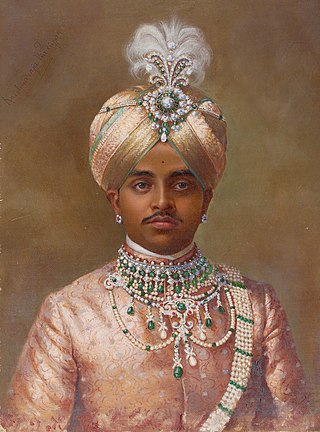
Krishnaraja Wadiyar IV (Kannada: ನಾಲ್ವಡಿ ಕೃಷ್ಣರಾಜ ಒಡೆಯರು; 4 June 1884 – 3 August 1940) was the twenty-fourth Maharaja of Mysore, reigning from 1902 until his death in 1940.
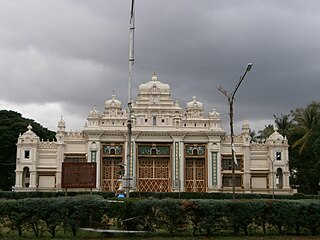
Jaganmohana Palace, officially Sri Jayachamarajendra Art Gallery, is a royal mansion, arts museum and auditorium, and formerly an alternative royal residence of the ruling maharaja of Mysore, located in Mysore, India, about 200m (600ft) to the west of Mysore Palace. Began in 1856 and completed in 1861, the palace is one of the oldest modern structures in Mysore.
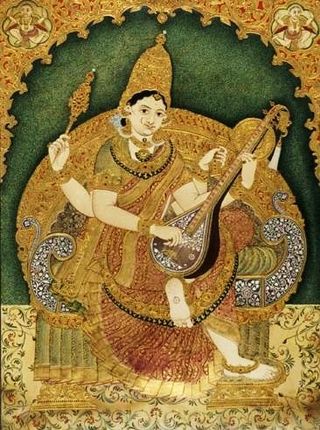
Mysore painting is an important form of classical South Indian painting style that originated in and around the town of Mysore in Karnataka encouraged and nurtured by the Mysore rulers. Painting in Karnataka has a long and illustrious history, tracing its origins back to the Ajanta Caves period. The distinct school of Mysore painting evolved from the paintings during the Vijayanagara Empire period, the rulers of Vijayanagara and their feudatories encouraged literature, art and architecture as well as religious and philosophical discussions. With the fall of the Vijayanagara Empire after the 1565 Battle of Talikota, the artists who were until then under royal patronage migrated to various places such as Mysore, Tanjore and Surpur among others. Absorbing the local artistic traditions and customs, the erstwhile Vijayanagara school of painting gradually evolved into the many styles of painting in South India, including the Mysore and Tanjore schools of painting.
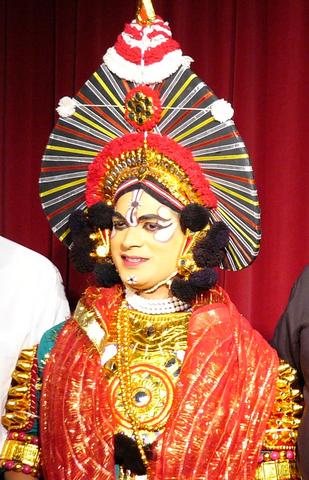
Karnataka, a southern state in India, has a distinct art style and culture informed by a long history of diverse linguistic and religious ethnicities. Apart from Kannadigas, Karnataka is home to Tuluvas, who also consider themselves as Kannadigas. Minor populations of Tibetan Buddhists, Siddhi tribes, and a few other ethnic groups also live in Karnataka. The traditional folk arts are major theatrical forms in coastal Karnataka. Contemporary theatre culture in Karnataka is one of the most vibrant in India, with organizations like Ninasam, Ranga Shankara, and Rang on foundations laid by the Gubbi Veeranna Nataka Company. Veeragase, Kamsale, and Dollu Kunitha are popular dance forms. Bharatanatya also enjoys wide patronage in Karnataka.
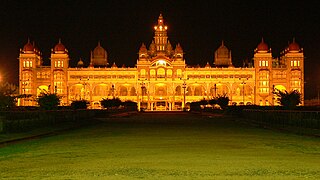
Mysore is a city in the state of Karnataka, India. It is known as the cultural capital of Karnataka. Mysore was the capital of the Wodeyar kings who ruled over the Mysore Kingdom for many centuries. Wodeyars were great patrons of art and music and have contributed significantly to make Mysore a cultural centre. Mysore is well known for its palaces, museums and art galleries and the festivities that take place here during the period of Dasara attract a worldwide audience. Mysore has also lent its name to popular dishes like Mysore Masala Dosa and Mysore Pak. Mysore is also the origin of the popular silk sari known as Mysore silk sari and has also given rise to a popular form of painting known as Mysore painting.

The Kingdom of Mysore (1399–1950) was founded by Yaduraya in 1399 as a feudatory of the Vijayanagara Empire and became an independent kingdom in the early 17th century, after the decline of the Vijayanagara Empire. Many musicians and composers have presumably adorned the courts of the Mysore kings from Yaduraya's time, furthering the Dakshinadi school of music that had developed in earlier centuries. However, records are only available from the time of King Ranadheera Kanteerava Narasaraja Wodeyar (1638). Musical treatises surviving from this time, though, provide ample information on the music, musical instruments, the types of compositions, the raga (melodies) and the tala (rhythms) used. Though all the Mysore kings patronised music, the golden age of Carnatic music was considered to be during the reigns of Kings Krishnaraja Wodeyar III (1794–1868), Chamaraja Wodeyar IX (1862–1894), Krishnaraja Wodeyar IV (1884–1940) and Jaya Chamaraja Wodeyar (1919–1974). The reign of Krishnaraja Wodeyar IV is regarded as particularly important in musical terms.
Nittoor Srinivasa Rao or Nittur Srinivasa Rao was a Gandhian who participated in the Indian independence movement. He was the Chief Justice of the High Court of Mysore State and also the first chief of the Central Vigilance Commission of India. He was also chosen as the acting Governor of the Mysore state and was the first person to translate Mahatma Gandhi's autobiography to the Kannada language.

Krishnaraja Wadiyar III was the twenty-second maharaja of the Kingdom of Mysore. Also known as Mummadi Krishnaraja Wadiyar, the maharaja belonged to the Wadiyar dynasty and ruled the kingdom for nearly seventy years, from 30 June 1799 to 27 March 1868. He is known for his contribution and patronage to different arts and music during his reign. He was succeeded by his grandson Maharaja Chamarajendra Wadiyar X.

The antiquity of architecture of Karnataka can be traced to its southern Neolithic and early Iron Age, Having witnessed the architectural ideological and utilitarian transformation from shelter- ritual- religion. Here the nomenclature 'Architecture' is as old as c.2000 B.C.E. The upper or late Neolithic people in order to make their shelters, they constructed huts made of wattle and doab, that were buttressed by stone boulders, presumably having conical roof resting on the bamboo or wooden posts into red murram or paved granite chips as revealed in archaeological excavations in sites like Brhamagiri, Sanganakallu, Tekkalakota, Piklihal. Megaliths are the dominant archaeological evidence of the early Iron Age. There are more than 2000 early Iron Age burial sites on record, who laid the foundation for a high non-perishable architecture in the form of various distinct architectural styles of stone built burials, which are ritualistic in its character. The active religious architecture is evident 345 with that of the Kadamba Dynasty. Karnataka is a state in the southern part of India originally known as the State of Mysore. Over the centuries, architectural monuments within the region displayed a diversity of influences, often relaying much about the artistic trends of the rulers of twelve different dynasties. Its architecture ranges dramatically from majestic monolith, such as the Gomateshwara, to Hindu and Jain places of worship, ruins of ancient cities, mausoleums and palaces of different architectural hue. Mysore Kingdom (Wodeyar) rule has also given an architectural master structure in the St. Philomena's Church at Mysore which was completed in 1956, in addition to many Dravidian style architectural temples. Two of the monuments are listed under the UNESCO World Heritage List of 22 cultural monuments in India. Styles of Indo-Saracenic, Renaissance, Corinthian, Hindu, Indo-Greek and Indo-British style palaces were built in Mysore, the city of palaces. Sikh architecture at Bidar (1512) and also in Bangalore in 1956 can also be cited as having an impact on the architectural composition of the state.
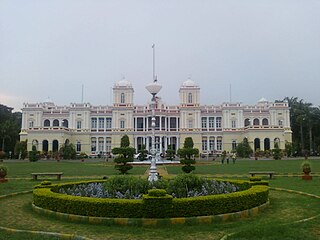
Cheluvamba Mansion is located in the city of Mysore, Karnataka. It was built by Maharaja Krishnaraja Wodeyar IV for the third princess of Mysore - Cheluvajammanni and it is similar to other mansions built by them which are spread over a large area surrounded by gardens. This mansion is crafted like other buildings of the Wadiyar dynasty.
Padmashree Singannachar Narasimha Swamy was an Indian artist who lived and worked in India his whole life. An alumnus of Chamaraja Technical Institute, Mysore and Sir J.J School of Arts, Bombay, Swamy, as affectionately referred to, moved around in high circles, with friendships with Pandit Jawaharlal Nehru, Mahatma Gandhi, Lord Mountbatten of Burma and the like. His paintings and other works of art can be found in various government offices, museums and personal collections around the world.

Baadal Nanjundaswamy is an Indian painter. An alumnus of Chamarajendra Academy of Visual Arts (CAVA), he is most popular for his street art and 3D paintings. He lives in Bangalore.

Renuka Kesaramadu is a contemporary painter and sculptor from India. She is best known internationally through her collaborative art exhibitions and participations in workshops in Europe. She has also curated a few international art symposia and exhibitions in India.
Shanthamani Muddaiah is a sculptural artist who uses ephemeral natural materials in her visual art work such as paper and charcoal to create, install and display exhibits. Her sculptures have been exhibited in many biennial art shows in India and at many international centers. She has received many awards for her works.

Y. Subramanya Raju was an Indian artist who patronized the Mysore style of traditional art. He was born into a family of court painters in the princely state of Mysore. The Mysore Dasara Procession paintings which adorn the walls of the Kalyana Mantapa in the Mysore Palace are few of his exquisite works. In the later years, Raju involved himself with the Karnataka Chitrakala Parishath for the promotion of fine art and artists in the State. Raju spent most of his years teaching and popularizing Mysore style of art, as a recognition, Emeritus Fellowship was awarded by the Ministry of Human Resource Development and the Government of India gave its National Award for his excellence in Traditional Mysore Painting.














